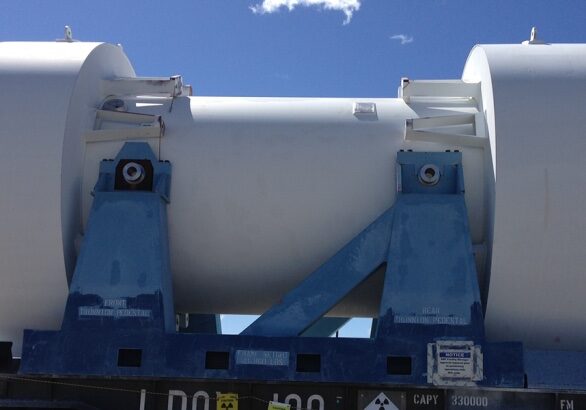Likely high-level radioactive waste transport routes across Ohio

The above image shows a giant rail cask for shipping high-level radioactive waste. Most shipments would be by rail, although Heavy Haul Trucks on roadways, Legal Weight Trucks on interstate highways, and even barge shipments — as on rivers, seacoasts, and even the Great Lakes — are possible as well.
See the most likely transport routes across the State of Ohio for highly radioactive wastes bound for dump-sites out West:
OHIO States_AffectedSee a closeup of the most likely transport routes through the metro Cleveland region:
CLEVELAND LANDSCAPE PowerPoint Presentation - Cities_AffectedThese maps were generated by Dr. Fred Dilger in 2017, using the U.S. Department of Energy’s own computer models. The context was Yucca Mountain, Nevada-bound shipments, for permanent geologic disposal of irradiated nuclear fuel on Western Shoshone Indian land just northwest of Las Vegas. Dr. Dilger now serves as Director of the State of Nevada Agency for Nuclear Projects, a division of the governor’s office.
But the routes to ship wastes to Nevada, as far east as Ohio, would be similar or identical to the routes to ship waste to CIS facilities out West — currently targeted at New Mexico and Texas. U.S. Rep. Kaptur’s support for CIS — as with tens of millions of dollars of federal taxpayer funding annually — is inviting large numbers of high-risk, high-level radioactive waste shipments to travel through Ohio.
Note that Davis-Besse and Perry nuclear power plant export shipments out West would be high-risk themselves. But the vast majority of shipments to travel through Ohio would originate in other states, and merely pass through Ohio en route to one or more Western dumps.
The State of Nevada Agency for Nuclear Projects has established that high-level radioactive waste shipments have a “Radiological Regions of Influence” (risk and impacts, ROIs). One ROI extends 0.5 miles on either side of the shipment, for “allowable” or “permissible” releases of radiation (emissions of hazardous gamma and neutron radiation) during “routine” or “incident-free” shipments. Shipments externally contaminated — a frighteningly common occurrence — could dramatically increase such dose rate impacts and risks. For a breach of container, as due to a severe accident or intentional attack, shipments would have a 50-mile Region of Influence on either side of the shipping container, Nevada has established. To learn more about these issues, see Nevada’s legal contention posted here (the second embedded document in the post). Also see the route map of inbound shipments to the proposed Interim Storage Partners, LLC (ISP) supposedly “private” (with heavy, illegal DOE involvement and taxpayer funding) in Andrews County, West Texas, on Page 6 (Figure 2) of Western Interstate Energy Board comments to the U.S. Nuclear Regulatory Commission regarding the ISP Draft Environmental Impact Statement (the topmost embedded document at the post).
Support Beyond Nuclear
Help to ensure a safer, greener and more just world for all

